Intact forest landscapes — large mosaics of ecosystems anchored by forests and unaffected by humans — are on the decline worldwide, according to a new analysis of satellite data.
By John C. Cannon
The map above shows the intact forest landscape loss between 2000 and 2013 regionally throughout the world. (Map: Carla Schaffer/AAAS)
Few places on Earth escape the reach of humankind, and those areas are dwindling, according to a new study. Between 2000 and 2013, the world lost a Venezuela-sized expanse of untouched forests — what scientists call intact forest landscapes.
“Humanity is expanding its footprint by converting more and more of these areas,” says Lars Laestadius, a forester at Laestadius Consulting in Silver Spring, Maryland. Laestadius co-authored a study recently published in the journal Science Advances.
Intact forest landscapes, or IFLs, are known for bottling up huge amounts of carbon from the atmosphere, housing arrays of animal and plant life that live in few other places, and delivering critical services such as shuttling water through the ecosystem. But the study shows that more than 7 percent of the IFLs that existed in 2000 had disappeared from the map by 2013, mostly due to our need for timber and land for agriculture.
The term for IFLs in Russian is “little disturbed,” Laestadius says, and, while their contributions to the global carbon budget and biodiversity are important, these blocks of pristine landscapes are valuable in other ways that are harder to measure.
Among them is the “reference point” they provide for what a natural system should look like, he said. “Only then do we have a benchmark to understand what’s happening to the rest of the world.”
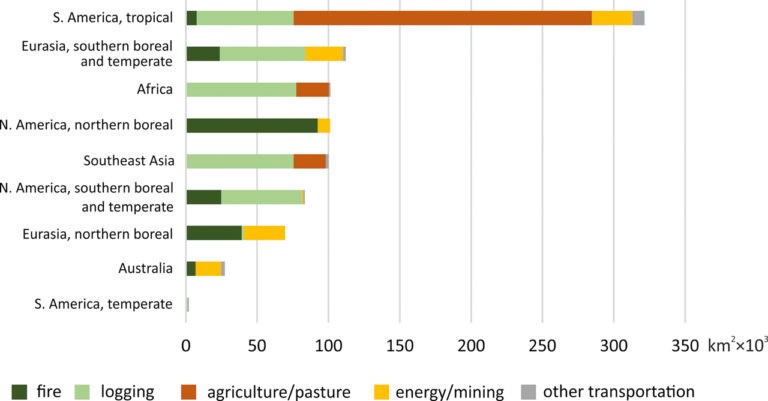
Globally, timber extraction and agricultural expansion caused the most IFL loss, but the regional causes varied widely. (Chart: Potapov et al./Science Advances)
Laestadius and his colleagues at the University of Maryland, along with several organizations in North America, Europe, and Asia, combed through satellite data collected since 2000, flagging untouched landscapes that had 20 percent or greater tree canopy cover and were at least 500 square kilometers (193 square miles) in size.
They recognize that humans have affected most places on Earth in some way, but none of the places classified as IFLs in this study showed signs of impact on the satellite images. And nor are they the same as primary forests.
Though IFLs often contain primary (or old-growth) forests, the team targeted these larger swaths to capture entire landscapes in their analysis. Indeed, stands of primary forest that are part of IFLs are vital carbon repositories in the tropics. The ones identified in this study account for 40 percent of aboveground carbon there, even though they only make up 20 percent of the total tropical forest area.
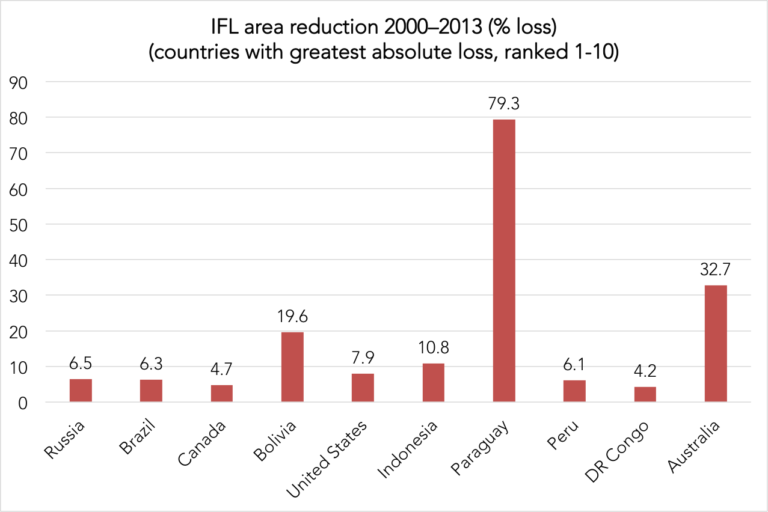
IFL percent reduction 2000–13 in countries with the greatest absolute loss. Among all countries, Paraguay had the greatest proportional loss of IFLs, losing nearly 90 percent of its IFLs between 2000 and 2013. (Data: Potapov et al./Science Advances)
But IFLs also contain bodies of water and “naturally treeless” expanses — critical elements that allow the “landscape” designation, along with how big it is. The authors write, “[T]he larger the size, the higher the conservation value of the territory.”
The problem is, when you break up these big systems, they can’t support as many of the plants and animals — in terms of both individual numbers and species diversity — that forests so famously safeguard. Scientists have also found that smaller pristine plots don’t hold up as well to “natural disturbance,” such as wildfire, and they aren’t as robust when faced with a changing climate.
“In the past we’ve thought a lot about biodiversity hotspots, for example, or large carbon stores in forests,” says Gillian Galford, an ecologist at the University of Vermont, who was not involved in the research. “I think that this metric of intact forest landscapes encompasses many of those things.
“It provides a really new and interesting and useful set of information,” Galford adds.
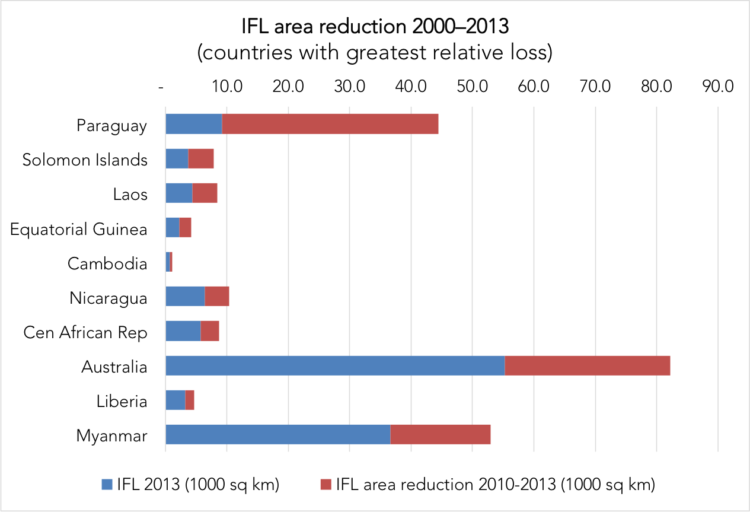
IFL area reduction 2000–13 in countries with the greatest relative loss. The full length of the blue and red bars shows the extent of IFLs in each country in 2000, and the red bars represent the IFL area lost by 2013. (Data: Potapov et al./Science Advances)
Finding those areas, though, is becoming more difficult, as Laestadius and his colleagues discovered. Some 919,000 square kilometers (354,828 square miles) of IFLs that were present at the beginning of the 21st century were gone by 2013.
The news gets worse for the tropics, where nearly two-thirds of the loss occurred and the rate is accelerating. Three times as many IFLs vanished from equatorial forests in Africa, South America, and Southeast Asia between 2011 and 2013 compared to the period of 2001 to 2003.
The analysis drilled into the statistics to show that several tropical countries are already barreling toward an IFL-less future. During the time period studied, Paraguay lost nearly 80 percent of its IFLs, and Cambodia hemorrhaged more than 38 percent. At this rate, both countries, as well as Laos and Equatorial Guinea, won’t have any untouched forest landscapes left by the 2030s.
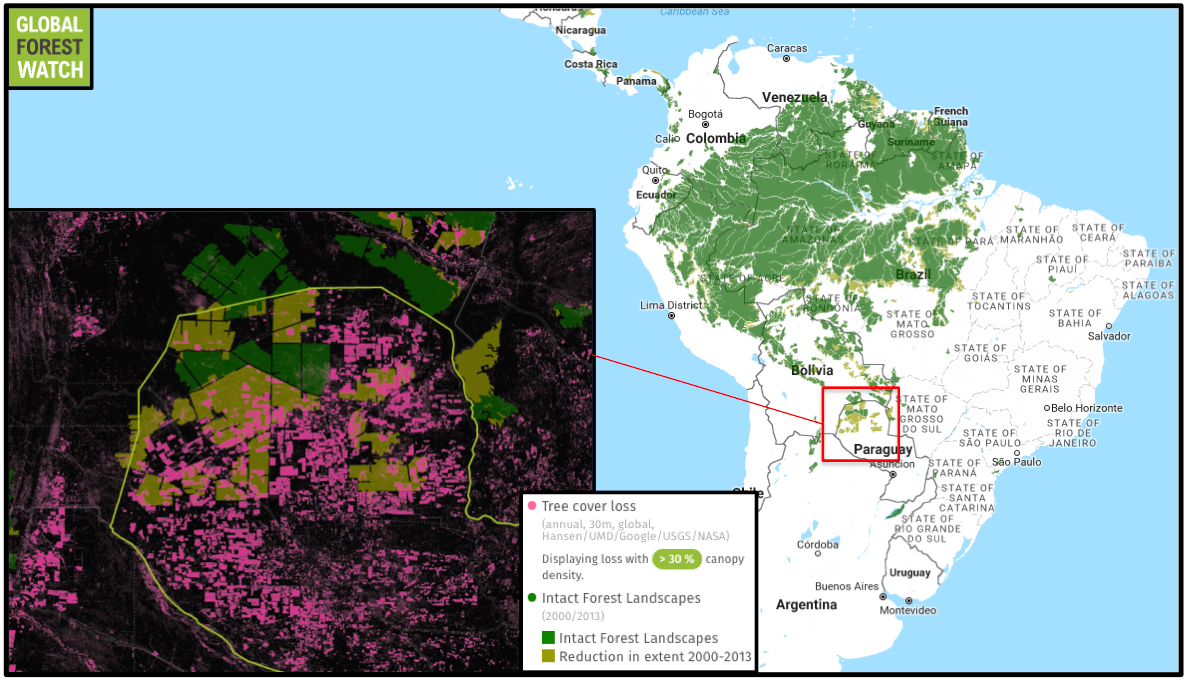
Data from Global Forest Watch shows heavy tree cover loss in Paraguay’s remaining IFLs from 2001 through 2014; the new study finds that the country lost 80 percent of its IFLs between 2000 and 2013. (Map: Global Forest Watch)
Galford says the concentration of IFL loss was striking. “More than half of that was contributed by just three countries — Russia, Brazil, and Canada,” she says, adding that, at least by identifying them, it “could help us target locations for more sustainable forest development.”
Brazil alone lost 157,000 square kilometers (60,618 square miles) of IFLs — the most in the tropics. Galford points out that Brazil is trying to find solutions. In the Amazon, she says, soy farmers and cattle ranchers have pledged to halt any new deforestation.
But in many ways, Brazil is unique, Laestadius says. “Brazil is beginning to grapple with the problem, but most [other countries] are not,” he says.
The researchers looked at other efforts to protect forests to see whether they resulted in IFL protection. Their analysis showed that protected areas such as parks and reserves do a decent job of protecting IFLs from being lost to timber operations, but they were less of a defense against agricultural expansion.
And certification schemes such as those laid out by the Forestry Stewardship Council fell short: Central African countries lost just as much or more IFL area from certified concessions as from uncertified ones, even though a 2014 motion passed by the organization’s general assembly was aimed at specifically bolstering IFL protection.
In addition to these frameworks for protecting wilderness, Laestadius says, “What you need more than anything else is the will to protect these areas.”
He and the other authors note that Uganda, the Dominican Republic, Thailand, and Cuba had all held onto more than 90 percent of their IFLs.
And yet, the data indicates that several heavily forested countries still flush with IFLs, including Gabon and the Republic of the Congo, could lose their IFLs within 60 years if they don’t alter course. Bolivia, Myanmar, and Cameroon risk sharing the same fate.
In that caution, however, Galford says she sees the strength of having this type of information available. “By raising a red flag about the 60-year period,” she says, “that’s a period in which these countries have a significant opportunity to change that trajectory.”
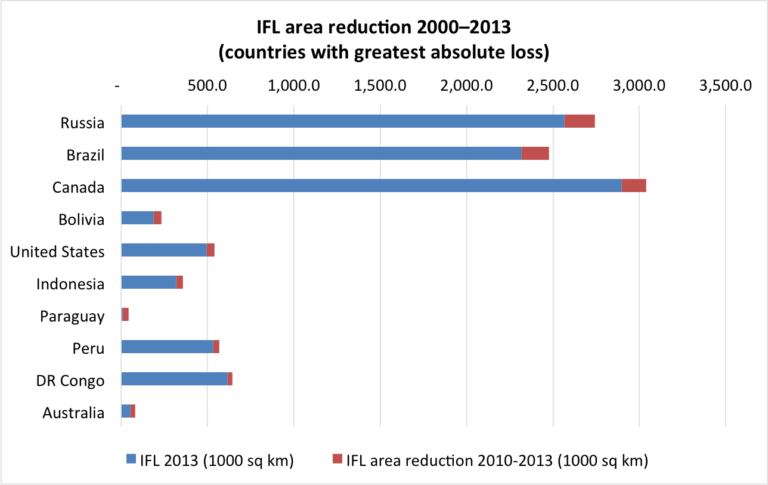
IFL area reduction 2000–13 in countries with the greatest absolute loss. The full length of the blue and red bars shows the extent of IFLs in each country in 2000, and the red bars represent the IFL area lost by 2013. (Data: Potapov et al./Science Advances)
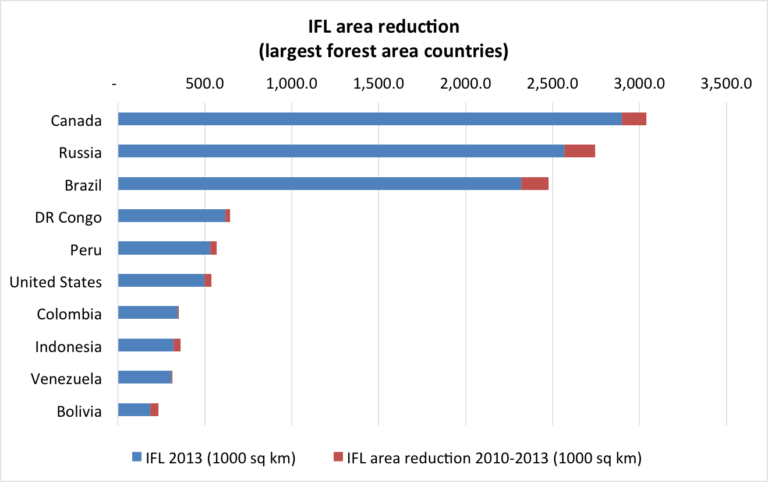
IFL area reduction 2000–13 in countries with the largest forest areas. The full length of the blue and red bars shows the extent of IFLs in each country in 2000, and the red bars represent the IFL area lost by 2013. (Data: Potapov et al./Science Advances)
This story originally appeared at the website of global conservation news service Mongabay.com. Get updates on their stories delivered to your inbox, or follow @Mongabay on Facebook, Instagram, or Twitter.





